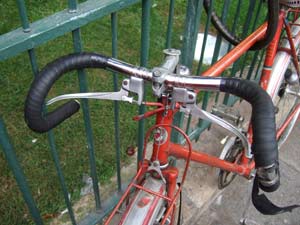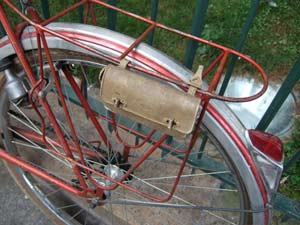 Valuable? Only to its owner |
 Sweeping Randonneur bars with matching Mafac brake levers |
 Note rack strut curved around cantilever brake |
Until as recently as the late 1970s, French cycle tourists almost without exception rode bicycles rolling on wheels with 650B tyres. This format, which runs on a 584mm rim and is notable for a tyre width of between 30mm and 50mm, almost died out by the end of the 1980s. Tyre supplies dwindled as the French road market increasingly turned to the 700C format (622mm rim) modelled on the tyre and wheel sizes used by racing cyclists. At the same time, the previously unpopular 26 inch tyred 559 rim size became the size of choice for mountain bikes, leaving the 650B squeezed from both sides.
So what ? Isn’t this an example of the natural extinction of a size that proved less suitable for various purposes than the tyres that have largely superseded it ? Not according to the Confrerie des 650B, which is an organisation, French naturally, dedicated to the preservation of one of the glories of French cycling culture. The 650B gained popularity thanks to performances in the touring trials held across Europe before World War Two. The smaller roads of the day were largely unsurfaced, especially in the mountains, and the wide 650B tyre proved perfect for the conditions under which these technical trials were held.
Leading manufacturers, or ‘constructeurs’, of French touring bikes, such as the legendary Rene Herse, built machines around the tyre, which in turn became the subject of much refinement. At its apogee, the 650B touring cycle boasted derailleur gears when Tour de France riders were still on flip-flop hubs, hub generator lighting, cantilever brakes, handmade lightweight luggage racks front and rear and supple, lightweight, handmade ‘ballon’ tyres with thin treads and sidewalls running at pressures as low as 45psi.
The format’s success owed much to the fact that a fat 38mm 650B tyre has about the same diameter as a narrow 22mm 700C tyre, so it rides over bumps as readily, but the wide tyre section offers low rolling resistance even at low tyre pressures. The resulting comfort and improved roadholding are said to be so impressive that the format is worthy of being saved. The Confrerie, established in 1995, has worked with tyre manufacturers including Michelin and Panaracer and rim companies including Rigida and Sun to ensure the ongoing viability of the format, which is now increasingly popular not just in France but in the USA, Japan and even Australia. Oddly enough, there is no real 650B scene in the UK ; Entente Cordiale, anybody ?
The 1970s cycle pictured, seen chained to a railing in the 5th Arrondisement of Paris, is no ‘constructeur’ bike, being not old enough, too heavy and clearly mass-produced. However, it has the right lines and, with its elaborate racks, ‘Randonneur’ handlebars, dynamo, Mafac brakes and aluminium mudguards, ticks all the 650B boxes. Vive la 650B!





